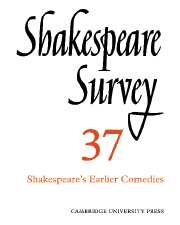Book contents
- Frontmatter
- Criticism of the Comedies up to The Merchant of Venice: 1953–82
- Plotting the Early Comedies: The Comedy of Errors, Love’s Labour’s Lost, The Two Gentlemen of Verona
- The Good Marriage of Katherine and Petruchio
- Shrewd and Kindly Farce
- Illustrations to A Midsummer Night’s Dream before 1920
- The Nature of Portia’s Victory: Turning to Men in The Merchant of Venice
- Nature’s Originals: Value in Shakespearian Pastoral
- 'Contrarieties agree': An Aspect of Dramatic Technique in Henry VI
- Falstaff’s Broken Voice
- ‘He who the sword of heaven will bear’: The Duke versus Angelo in Measure for Measure
- War and Sex in All’s Well That Ends Well
- Changing Places in Othello
- Prospero’s Lime Tree and the Pursuit of Vanitas
- Shakespearian Character Study to 1800
- How German is Shakespeare in Germany? Recent Trends in Criticism and Performance in West Germany
- Shakespeare Performances in Stratford upon–Avon–and London, 1982–3
- The Year's Contributions to Shakespearian Study 1 Critical Studies
- 2 Shakespeare’s Life, Times and Stage
- 3 Editions and Textual Studies
- Index
War and Sex in All’s Well That Ends Well
Published online by Cambridge University Press: 28 March 2007
- Frontmatter
- Criticism of the Comedies up to The Merchant of Venice: 1953–82
- Plotting the Early Comedies: The Comedy of Errors, Love’s Labour’s Lost, The Two Gentlemen of Verona
- The Good Marriage of Katherine and Petruchio
- Shrewd and Kindly Farce
- Illustrations to A Midsummer Night’s Dream before 1920
- The Nature of Portia’s Victory: Turning to Men in The Merchant of Venice
- Nature’s Originals: Value in Shakespearian Pastoral
- 'Contrarieties agree': An Aspect of Dramatic Technique in Henry VI
- Falstaff’s Broken Voice
- ‘He who the sword of heaven will bear’: The Duke versus Angelo in Measure for Measure
- War and Sex in All’s Well That Ends Well
- Changing Places in Othello
- Prospero’s Lime Tree and the Pursuit of Vanitas
- Shakespearian Character Study to 1800
- How German is Shakespeare in Germany? Recent Trends in Criticism and Performance in West Germany
- Shakespeare Performances in Stratford upon–Avon–and London, 1982–3
- The Year's Contributions to Shakespearian Study 1 Critical Studies
- 2 Shakespeare’s Life, Times and Stage
- 3 Editions and Textual Studies
- Index
Summary
I wish to pursue G. Wilson Knight’s suggestion that All’s Well That Ends Well is built on a conflict between the masculine concept of honour as prowess in war and the feminine concept of honour as chastity in love. However, whereas Knight goes on to interpret the conclusion as an almost mystical victory for transcendent chastity in which ‘sanctity aspires to sexuality’ (p. 160), I propose to pick up his puzzling concept of Helena’s ‘bisexuality’ to suggest instead that the conflict of the play is resolved by having each ideal – war and love – modify the other, so that the conclusion takes the form of a wry accommodation between them in which the purity of both ideals has had to be abandoned. As in Troilus and Cressida (echoed in All’s Well) where there is a similar intercontamination of war and sex, this accommodation is seen through a consciousness of passing time. Shakespeare has added to his source an important framework of death-haunted and nostalgic elders – the Countess, Lord Lafew, Lavache, and the melancholy King of France (who has a much more important part in the play than in Boccaccio) – which places the lovers’ struggle in a perspective of succeeding generations, so that the young have to work out their relationships against their elders’ fears and expectations for them.
- Type
- Chapter
- Information
- Shakespeare Survey , pp. 99 - 114Publisher: Cambridge University PressPrint publication year: 1984
- 2
- Cited by

